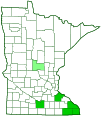snowy campion
(Silene nivea)
Conservation • Wetland • Description • Habitat • Ecology • Use • Distribution • Taxonomy
Conservation Status |
|
|||||||
| IUCN Red List | not listed |
|||||||
| NatureServe | N4? - Apparently Secure S2 - Imperiled |
|||||||
| Minnesota | Threatened |
|||||||
Wetland Indicator Status |
||||||||
| Great Plains | FACW - Facultative wetland |
|||||||
| Midwest | FACW - Facultative wetland |
|||||||
| Northcentral & Northeast | FACW - Facultative wetland |
|||||||
Description |
||
Snowy campion is a 12″ to 36″ tall, erect, perennial forb that rises from an elongated rhizome. The stems are erect, unbranched or sparsely branched, and leafy. The stem leaves are in opposite pairs. They are elliptic to lance-shaped, 2″ to 4″ long, ⅜″ to 1⅓″ wide, largest near the middle of the stem, smaller and withering toward the base. They taper gradually to a long pointed tip with concave sides along the tip. They are attached to the stem on a short leaf stalk or no stalk at all. The margins are untoothed. The inflorescence is an open, leafy cluster of 1 to 12 but usually 3 to 5 flowers. The sepals are fused at the base into a tube (calyx) terminating in 5 short lobes. The calyx is ⅓″ to ⅔″ long, from less than ¼″ to ⅓″ wide. It has a broad base with a navel-like indentation. It is green and broadly tubular to bell-shaped. It has 10 obscure green veins with no obvious network of veins between them. It has no ribs and is either hairless or densely covered with hairs. Flowers are about ½″ wide when fully open, and are on stalks that are 2 to 2½ times as long as the calyx. The 5 petals are white, 2-lobed, with a stalk-like narrow base (claw). The 10 stamens and 3 styles protrude slightly from the calyx. The flowers open in the evening. The fruit is a green, hairless, egg-shaped, 1-chambered capsule the same size as the calyx, with 3 teeth at the top that sometimes split and appear to be 6 teeth. |
||
Height |
||
12″ to 36″ |
||
Flower Color |
||
White |
||
Similar Species |
||
| Snowy campion is recognized by the green calyx with obscure veins and a broad base with a navel-like indentation. | ||
Habitat |
||
Moderate moisture. Openings in alluvial forests and meadows. |
||
Ecology |
||
Flowering |
||
June to August |
||
Pests and Diseases |
||
|
||
Use |
||
|
||
Distribution |
||||
|
Sources The outlier in Morrison County (light green on the map) is from the Field Museum of Natural History (Botany) Seed Plant Collection in Chicago, Illinois. Three plants were collected in August 1891. |
|||
| 2/22/2023 | ||||
Nativity |
||||
Native |
||||
Occurrence |
||||
Rare in Minnesota |
||||
Taxonomy |
|||
| Kingdom | Plantae (Plants) | ||
| Subkingdom | Pteridobiotina | ||
| Phylum | Tracheophyta (Vascular Plants) | ||
| Class | Magnoliopsida (Dicots) | ||
| Subclass | Caryophyllidae | ||
Order |
Caryophyllales (Pinks, Cactuses, and Allies) | ||
Family |
Caryophyllaceae (Pink) | ||
| Subfamily | Caryophylloideae | ||
| Tribe | Sileneae | ||
Genus |
Silene (catchflies) | ||
| Subgenus | Behenantha | ||
Subordinate Taxa |
|||
|
|||
Synonyms |
|||
Cucubalus niveus Silene alba |
|||
Common Names |
|||
evening campion snowy campion snowy catchfly |
|||
Glossary
Calyx
The flower cup. May be the group of outer floral leaves (sepals) collectively, or a tube with lobes.
Claw
A stalk-like narrowed base of some petals and sepals.
Visitor Photos |
|||||
Share your photo of this plant. |
|||||
| This button not working for you? Simply email us at info@MinnesotaSeasons.com. Attach one or more photos and, if you like, a caption. |
|||||
|
|||||
MinnesotaSeasons.com Photos |
|||||
|
|||||

Slideshows |
||

Visitor Videos |
|||
Share your video of this plant. |
|||
| This button not working for you? Simply email us at info@MinnesotaSeasons.com. Attach a video, a YouTube link, or a cloud storage link. |
|||
Other Videos |
|||

Visitor Sightings |
|||||
Report a sighting of this plant. |
|||||
| This button not working for you? Simply email us at info@MinnesotaSeasons.com. Be sure to include a location. |
|||||
|
|||||
MinnesotaSeasons.com Sightings |
|||||
|
|||||

|
Created: Last Updated: © MinnesotaSeasons.com. All rights reserved. |
